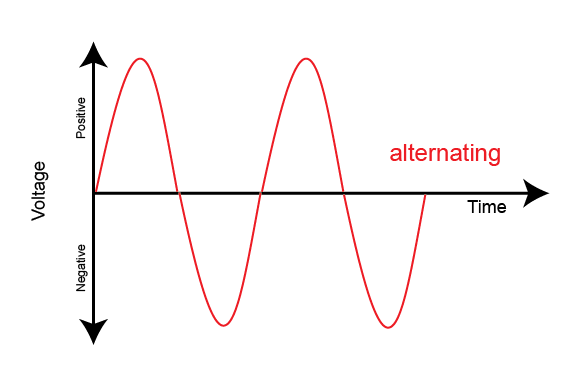The term AC stands for Alternating Current. It is a current in which the movement of an electric charge reverses direction on a regular basis. In other words, alternating current varies its direction and magnitude on a regular basis, i.e., it starts at zero, increases to a maximum, returns to zero, grows to a maximum in the opposite direction, and finally returns to zero. Nikola Tesla invented an alternating current.

Alternating Current Production
Table of Contents
Alternators are devices that create alternating currents. However, there are several ways to generate AC by utilizing various circuits. Aside from that, one of the simplest ways to generate AC is to use a single-coil AC generator, which consists of two-pole magnets and a single loop of rectangle-shaped wire. This method generates alternating current (AC) by using Faraday’s principle of electromagnetic induction, which converts mechanical energy into electrical energy.
Meanwhile, three wires are used to transmit alternating current to various types of devices. The list is as follows:
- The hot wire is used to transmit power.
- The neutral wire, which is grounded, serves as a return path for the current in the hot wire.
- The apparatus’s metallic components are connected to the third wire, which is also connected to the ground, principally to eliminate the risk of electric shock.
Also Read – What is the Full Form of REC?
Application of AC
The most common application of AC can be seen in examples like Radio Signals, Audio Signals, etc. As AC can carry electricity over longer distances and with little energy loss, its application is widely used in high-voltage power transmission.
Advantages of AC
- The hot wire is used to transmit power
- The neutral wire, which is grounded, serves as a return path for the current in the hot wire
- The apparatus’s metallic components are connected to the third wire, which is also connected to the ground, principally to eliminate the risk of electric shock
Also Read – What is the Full Form of EEE?
Disadvantages of AC
- Though less dangerous than DC, it is more enticing, in that, unlike DC, which generates an unpleasant shock, it attracts anybody who touches it
- Working with alternating current is far more dangerous than working with high-voltage direct current
- AC cannot be used for electrofishing, electroplating, or similar processes
- Batteries cannot be charged directly using alternating current
Popular Full Forms
We hope this blog has helped you understand the AC full form and everything related to it. If you want to know more, find the 300+ full forms list on our blog. In the world of short forms, you can rely on the Leverage edu page to know about more full forms like this! Connect with us study abroad experts to achieve your international dream today!
 One app for all your study abroad needs
One app for all your study abroad needs













